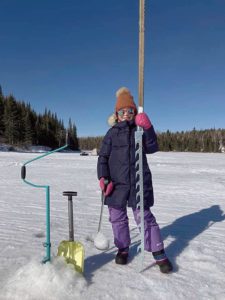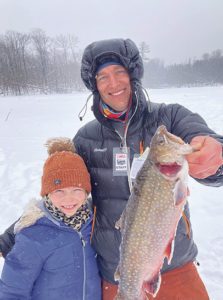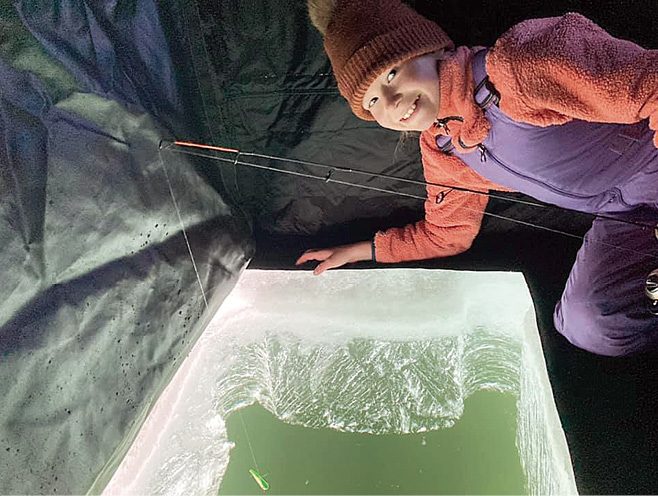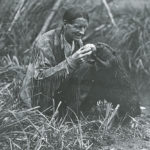Mystery is the biggest draw of fishing. What’s happening underwater? Are there even any fish in the area? Fishing is a game of questions. While gimmicky modern electronics aim to give answers with screens and flashes, there’s a heritage fishing technique that’s provided answers for millennia as well: sight fishing. Originally used by the First Nations peoples, sight fishing requires cutting a wide hole in the ice and covering it with a pitch-dark shelter, essentially transforming the lake into your own aquarium. Here’s the how and why of doing it yourself.
Sight fishing satisfies your curiosity by allowing you to see underwater. When you darken the area above your sight hole, the natural illumination filtering through the surrounding snow and ice, in contrast, lights up the world below you. Sunny days are perfect for sight fishing. The sport is particularly well suited to the clear water common in many northeastern Minnesota and Canadian lakes. It only takes a few simple tools to get started, and the results change how you look at fish, and fishing, forever.
The beauty of sight fishing is in its simplicity. First you cut an approximately 36-by-20-inch hole in the ice. This is where the muscle comes in. You’ll need an auger for drilling the four corners of the rectangle. Then you “connect the dots” with a manual ice saw. This long, large-toothed tool looks worrisome at first, but is enjoyable to use. There are several ice saw producers from the upper Midwest and northern Europe today. Running $120 to $150, an ice saw brings you back in time to the lives of our ancestors.
There’s a feeling of accomplishment to manually cutting through something as hard as ice. According to Rebecca Velde, a writer and first-time ice fisherwoman from Duluth who recently made her sight fishing debut in the Boundary Waters: “It was way easier than I thought it would be. It was like a hot knife cutting through butter. The ice was 15 inches thick, but we cut it in no time.” The more people you have in your group, the faster you can get the job done. Team building on ice!

The next step is either to push the rectangular block of ice down and under the surrounding ice shelf, or extract it out of the hole. To do the latter, try screwing a pair of ice screws into the block and giving a powerful pull. Dean Paron, a sight fisherman from Two Harbors, suggests best etiquette is to put the block back in the hole at the end of the day, so that it refreezes quickly, and to mark it with branches or other visible material. This prevents snowmobilers or other fishermen from accidentally falling in unknowingly.
The last step is to set up a portable shelter designed with a retractable floor. Ice Runner, out of Bovey, Minn., makes the Stalker portable shelter ($279.99) with a cut-out in the floor to fish through. The Stalker can be assembled in minutes, and is completely black inside, both to increase your visibility of fish below the ice, and to hide your movements. Now you’re ready to fish! Use your regular ice-fishing tackle through the sight hole—a short rod and small reel with a rattling jig tipped with a minnow is standard for trout, northern pike or walleye.
Once you’ve warmed up by drilling and sawing your sight hole, a new world opens up below. Your interaction with the aquatic life below satisfies your curiosity. Paron puts it this way: “I feel a lot more connected to nature when fishing through a sight hole. And then there’s that jolt of excitement when you see something big come through. Seeing the fish swimming right below the ice, fighting right under your feet, is quite exciting.”
Velde recounts looking through the sight hole on her winter camping trip to a remote border lake.
“It was so much more sensory than I thought ice fishing is. I honestly got a little scared because I was in this black room, in which all I could see was this crystal blue water, and I kept imagining myself falling into the hole. You’re looking straight down, and you can see through the water so well.”
But Velde’s fear evaporated when she had her first lake trout on within minutes.
“I thought it was super cool. It was so fast! I think we were in the ice hut for all of three minutes before I caught my first lake trout. I thought I’d be sitting out there a lot longer, like traditional fishing, where you have to wait. We were just talking about the spoon, and oh, I got one,” she says.

Was this dream debut all about beginner’s luck? Or did the sight fishing method have something to do with it? Velde explains: “I liked how the spoon was super reflective. I had a part in trying to get the fish to come over. I was making a circle with the spoon, and I’m sure that’s why the fish came to the hook. That feels good, because I felt like I was actually doing something, instead of just sitting there waiting for the fish to come. It felt active.”
Sight fishing can be a great way to introduce impressionable kids to ice fishing. They can observe crayfish crawling on bottom, or watch minnows swimming by. The weeds, rocks and even sunken trees are on full display.
“Observing fish behavior is fascinating. When you’ve got a bobber, or even a Vexilar, you know the fish is kind of there, but when you can jiggle your jig and actually watch it move a certain way, and that triggers the strike, then you learn a lot,” says Paron. “Or you see the fish ignore the way you jigged it. Other times you see three or four fish come in at once, and it’s often the little one that beats the bigger fish to your lure. Sight fishing is so incredible because it’s interactive.”
Being able to observe the fish before you set the hook adds a moment of thrilling suspense. Paron likens it to hunting.
“Sight fishing for big predator fish reminds me of deer hunting. You’re staring at the same piece of woods, and all of a sudden there’s a deer there. And with sight fishing, you’re staring at the same weed line, and suddenly there’s this nice big pike hanging out, and you feel your heart racing,” he says.
Visualizing fish hitting your lure is a thrill for all anglers. Topwater fishing for bass is popular in summer, and dry fly anglers pride themselves on catching trout on the surface, because they can witness the strike. Seeing the action makes it more real. This thrill, combined with the low tech, cheaper alternative to electronics while sight fishing, creates a strong connection to Native American fishing traditions, providing continuity in our Minnesota and Canadian fishing heritage. Try it and see what you’ve been missing under the ice.





